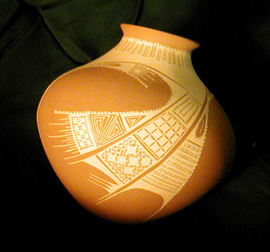 |
| Blood letting ceremony to perpetuate the cycle of life- nga.gov |
Life in Mesoamerica revolved around the many rituals that were incorporated into a person's progression into the stages of life. From birthing and fertility rituals to the coming of age rituals, there were many variations of ceremonies used by the cultural groups that inhabited the Mesoamerican landscape. Rituals and practices differentiated among the groups as well as the use of ceramics in said rituals. First we will look at fertility.
The first ritual a Mesoamerican would commonly participate in took place while one was unborn, as the first ritual was generally a fertility ritual. This event usually involved blood-letting -common amongst Mayan Groups- as letting blood demonstrated their 'paid' respect to their gods. Bloodletting for fertility meant showing devotion to their lineage and a wish to continue their family line. Ceramics such as vessels used to catch blood (Fig. 1) were used in conjunction with blood-letters. Ceramics were seen as a direct portal to the gods, therefore by putting the blood offering in the ceramics, it allowed a direct gift to them. Blood-letters, as demonstrated in the hands of the kneeling woman in the carved stone picture at the top of the page, varied in material from jade stone to ceremonial pieces of pottery, such as the one in Fig 2. These pieces served as the first ceramics used in the rituals of fertiltiy, in hope of the god's blessings in human and land re-productiveness and life.
In the Mayan culture, the goddess Ixchel (also known as Chek Chal), was the main deity in charge of fertility and birthing. Offerings were made to her. She was so highly regarded as the Goddess of midwifery, Ixchel had sanctuaries, such as Cozmuel and Isla Muerjes. The sanctuaries were in her honor, and women would go in order to seek favor, fertility, and even gender preferences from oracles given by the sacred statues (Fig 4 & 5). These ceramics and stone statues were greatly adorned with local dressings and offerings. Many have been lost to Spanish explorations unfortunately.
 |
| Figure 3. Birth ritual ceramic, used for water during naming ritual- neh.gov |
The next stage in the life of rituals were birth rituals. Following Mayan culture, Ixchel ceramics and stone figurines were placed underneath birthing hammocks to invoke Ixchel's powers and guardianship. This allowed the deity to watch over and protect the birth. In Aztec culture, however, after birth the midwife would perform a series of rituals. The rituals involved ceramic vessels of water, again, the ceramics allowed for ancestral connection via the ceramic. Figure 3 shows a vessel used in such birthing rituals, and is adorned with decorative art showing children participating in a water ritual. The child was bathed in the water of the vessel after birth, and then would receive its name.
The final ritual for children were coming of age rituals. These rituals were specialized to gender, and varied in ages for each. Boys generally started at 14, and girls started at 12, however girls were not considered fully of age until they gave birth to a child. During childhood, male children would have ceramic beads attached in their hair, and the release of these ceramic ritual objects meant they were an adult. Similarly, women after given birth had their hair washed in ceramic vessels, meaning their completeness into the adulthood. There was also sacrifical blood-letting that symbolized the realeasing of the blood of a child to the now-recognized adult.
These rituals were incorporated into Mesoamerican life, not only as a stage maker of individual growth, but as a form of cultural recognition and blessing. The various ways in which the rituals were done, whether blood-letting, sacred oracles, or bathing, these rituals helped to physically rectify and demonstrate the physical and mystological changes that came with life changes.
Depiction of Ixchel as the store/midwife goddess from a pre-conquest Mayan manuscript (Dresden Codex). She is the goddess of warfare, midwifery, weaving, rain, fertility, jaguars, and moon and flood phenomena. Typically shown pouring life by bringing water on earth, she is also know for sitting with a fertility rabbit or weaving on a loom.
The following were referenced in the writing of this article-
Codex Mendoza, prepared on the order of Don Antonia de Mendoza. Bodleian Library, MS. Arch. Selden. A. 1, fol. 57r. Annotated by Susan Douglass.
Day, Nancy. Your Travel to Ancient Mayan Civilization (Passport to History). Runestone Press, 2000.
 |
| Figure 4. Statue of Ixchel on the Islas Muerjes- Rights reserved to Sarunas Burdulis |






















